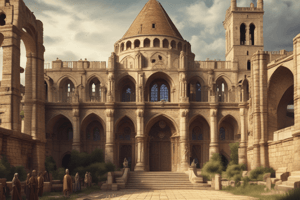Podcast
Questions and Answers
Where did Early Christian architecture primarily begin?
Where did Early Christian architecture primarily begin?
- Constantinople (correct)
- Athens
- Rome (correct)
- Jerusalem
The rise of Christianity was a significant influence on Early Christian architecture.
The rise of Christianity was a significant influence on Early Christian architecture.
True (A)
What architectural model did Early Christians adopt for their churches?
What architectural model did Early Christians adopt for their churches?
basilican model
What material was commonly used for constructing walls in Early Christian architecture?
What material was commonly used for constructing walls in Early Christian architecture?
Which part of basilica churches is known as the entrance?
Which part of basilica churches is known as the entrance?
The __________ of St. Peter was built by Constantine.
The __________ of St. Peter was built by Constantine.
What is the shape of the Baptistery of Constantine?
What is the shape of the Baptistery of Constantine?
Match the following tombs with their features:
Match the following tombs with their features:
Byzantium was known as 'New Rome'.
Byzantium was known as 'New Rome'.
What was a significant characteristic of Byzantine architecture's geographical influence?
What was a significant characteristic of Byzantine architecture's geographical influence?
Flashcards are hidden until you start studying
Study Notes
Early Christian Architecture
- Early Christian architecture originated in Rome and Constantinople, expanding throughout Europe and Asia.
- Influences on architecture stemmed from geographical, geological, climate, religious, social, political, and historical factors.
- Rome's geographical dominance facilitated the spread of architectural styles.
- Early structures predominantly used materials salvaged from Roman ruins, impacting the architectural character.
- Constantine's decree from Milan established Christianity as the Roman Empire's official religion, shaping architectural choices.
- The historical period is marked from Constantine's reign to Gregory the Great's influence.
Architectural Characteristics
- Early Christians faced financial constraints, prompting the use of existing Roman structures for worship.
- The basilica model became the preferred plan for churches, featuring a central nave and aisles.
- Circular churches were designated as baptisteries, promoting the new faith.
- Walls constructed from rubble or concrete, with internal mosaics enhancing aesthetic appeal.
- Openings included semi-circular arches and clerestory windows to allow light.
- Roofs featured wooden constructions with vaulted aisles and domed apses adorned with mosaics.
Key Elements of Basilica Churches
- Atrium: A forecourt that provided an imposing entrance, surrounded by arcades.
- Narthex: An area for penitents, covered and situated at the church's entry.
- Nave: The central aisle, lit by a clerestory of small windows.
- Aisles: Smaller passages flanking the nave, generally half its width.
- Transept: Modified spaces derived from pagan basilicas, also known as "bema" or "presbytery."
- Choir: Section enclosed by low screens or cancelli, typically near the altar.
- Altar: Positioned in front of the apse, serving as the focal point for worship.
- Baldachino: A canopy that often adorned altars.
- Propylaeum: The church entrance area.
Notable Basilicas
- St. Peter's Basilica: A pivotal structure built by Constantine featuring triple entrances and wooden roofs with interlocking rafters.
- S. Giovanni in Laterano: Another significant five-aisled basilica with similar architectural distinctions.
Baptisteries
- Used specifically for baptism rituals.
- Architectural forms were adapted from Roman circular temples and tombs.
- Notable examples include:
- Baptistery of St. Stefano Rotondo, Rome, Italy.
- Baptistery of Constantine, Rome, Italy, known for its octagonal shape and supported by eight columns.
- Arian Baptistery (Baptistery of Neon), Ravenna, Italy, featuring an octagonal plan and dual arcades.
Tombs
- Mausoleum of Sta. Costanza, Rome: Distinguished by its dome supported by granite columns.
- Tomb of Galla Placidia, Ravenna: A cruciform structure with sarcophagi and rich mosaic decorations.
Byzantine Architecture
- Byzantine architecture is rooted in the geographical and cultural essence of Byzantium, known as "New Rome."
- The lack of local building stone necessitated importing marble from the eastern Mediterranean.
- The hotter climate influenced building techniques and materials used.
- The Orthodox Church's prominence shaped architectural ideals and structures.
- Byzantium became a major commercial hub between East and West, affecting architectural trends.
- The Byzantine architectural style persisted until the fall of Constantinople in the 15th century.
Studying That Suits You
Use AI to generate personalized quizzes and flashcards to suit your learning preferences.




